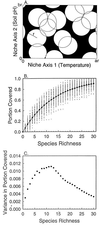Plant diversity and ecosystem productivity: theoretical considerations
- PMID: 11038606
- PMCID: PMC20007
- DOI: 10.1073/pnas.94.5.1857
Plant diversity and ecosystem productivity: theoretical considerations
Abstract
Ecosystem processes are thought to depend on both the number and identity of the species present in an ecosystem, but mathematical theory predicting this has been lacking. Here we present three simple models of interspecific competitive interactions in communities containing various numbers of randomly chosen species. All three models predict that, on average, productivity increases asymptotically with the original biodiversity of a community. The two models that address plant nutrient competition also predict that ecosystem nutrient retention increases with biodiversity and that the effects of biodiversity on productivity and nutrient retention increase with interspecific differences in resource requirements. All three models show that both species identity and biodiversity simultaneously influence ecosystem functioning, but their relative importance varies greatly among the models. This theory reinforces recent experimental results and shows that effects of biodiversity on ecosystem functioning are predicted by well-known ecological processes.
Figures



References
-
- Ewel J J, Mazzarino M J, Berish C W. Ecol Appl. 1991;1:289–302. - PubMed
-
- Vitousek P M, Hooper D U. In: Biodiversity and Ecosystem Function. Schulze E-D, Mooney H A, editors. Berlin: Springer; 1993. pp. 3–14.
-
- Naeem S, Thompson L J, Lawler S P, Lawton J H, Woodfin R M. Philos Trans R Soc London B. 1995;347:249–262.
-
- Naeem S, Thompson L J, Lawler S P, Lawton J H, Woodfin R M. Nature (London) 1994;368:734–737.
-
- Tilman D, Downing J A. Nature (London) 1994;367:363–365.
LinkOut - more resources
Full Text Sources

